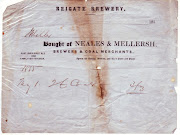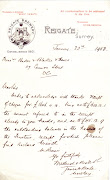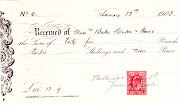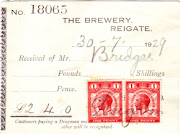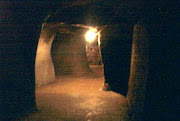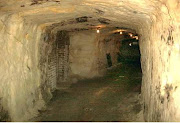MELLERSH AND NEALE - GROWTH AND PROSPERITY.
When Frederick Mellersh joined in 1854, the trading name of the business was altered from Neale & Sons, to Neale and Mellersh. Then in 1865, when Sisson Watts Neale joined the firm, the name was again changed to Neale, Mellersh, and Neale. When William Neale retired in 1883, the name of the undertaking altered once more to Mellersh and Neale. This then remained unchanged until the company was floated on the stock market in 1899 when the suffix "Limited" was added.
Sisson became an active partner in the undertaking and during the ensuing half a century greatly enlarged the firm. By his retirement in 19l9, the business had acquired 91 public houses in Surrey and Sussex, and his personal estates by the time of his death on 26th October 1930, amounted to £59,646.[1]. This was a great achievement considering that he was totally deaf. He lived at Browne's Lodge, on the north side of West Street. He married in l866 and had 10 children, three of whom were to join him later in the business. He was also extremely patriotic, joining the territorial army early on in his life, rising to the rank of Lieutenant Colonel by the time of his death.
For many years the Reigate brewery had been building up an export trade to the West Indies, especially Barbados, where the First Battalion of the Royal Scots was stationed. A letter, written in l885, and now in the hands of the museum of the Regimental Headquarters, Kings Own Royal Regiment at Lancaster, refers to the beer. Colonel Henry White, Commander in Chief of the Regiment in Barbados wrote: " Messrs. Whitfield & Co. has supplied the canteen of the battalion under my command with ale and porter of the Reigate Brewery. The beer supplied has given entire satisfaction to the officers and men and I consider it to be of excellent quality and well suited for consumption in a hot climate - the ale particularly.” On the margin of this letter are penned in an old hand, notes relating to the consignment in question. It was apparently brewed 20th January 1885; shipped by SS ATLANTIC and GEM on the 2nd February, 1885, and arrived in Barbados on the 8th May, 1885. The hand continues: " it must have been 8 months in Barbados” [2]. Figures quoted in the letter indicated that the beer retailed at between £17-£18 the kilderkin, duty paid, (the equivalent to £1 per gallon, or 12p a pint today).
A further note related to bottled beer: "bottled ale is so cheap that shop keepers do not care to bottle as they needed to do ten years ago.” Prices indicated seem to be 1/3d per dozen pints. The primary reason for this fall off in the price of bottled beer was the 1845 tax reduction on glass.
It may be noted that the above mentioned letter referred to two distinct types of beer - ale and porter. Perhaps a few words of explanation would be appropriate here. Porter has its roots back in the 18th century when landlords offered for sale ale, hopped beer, and cheap "twopenny" (two pence a quart) beer. Manual workers from the docklands of London prided themselves to be connoisseurs of malt liquors, and preferred a more subtle combination of flavours than either of these beers could alone impart. Consequently, they would call for half and half (half of ale and half of beer, or of twopenny). Alternatively, they would call for a pot of three threads (three thirds), this being an equal mixture of all three types of beer. Incessant demands for such popular mixtures ran the poor landlord off his feet, as for each demand, he had to go to three separate casks, and through three distinct operations, would draw one pint of beer.
The obvious solution dawned one day upon an exhausted Shoreditch innkeeper by the name of Ralph Harwood [3]. Why not devise a beer which combined the several virtues of ale, beer, and twopenny? Not only would the drawing be from one cask, but there would be a noticeable saving with regard wastage and shoe leather! His brainchild was put into production and marketed as Entire Butt Beer. The dockers loved it, and other brewers began to produce it, until it was sold eventually throughout the country. Availability of this new beer was announced on every pub wall with, just simply, the word Entire. A new word was coined for the beverage, Porter, a timely reminder of its origins among the porters and stevedores of London's East End [4].
In 1898, Sisson Watt Neale's three sons, Robert, James, and Reginald joined the business. It is interesting to note that the sons all made names for themselves in local sport. In their younger days they were actively connected with the Reigate Priory Cricket Club [5], and James Wilfred Neale (born 1876) would be found on most Saturdays occupying the " debatable ground”. Reginald Wilson Neale (born 1878) was a devotee of the game of lawn tennis and often played in the open tournaments of the Reigate Lawn Tennis Club. Robert Edward Neale (born 1871), like his two younger brothers, was also a prominent member of the Reigate Priory Cricket Club, and with them, was an able exponent of the game. James and Reginald also played for the old Rugby Football Club in which Dr. E. Bromet took a leading part. All three retained an active interest in sport, which they had done much to foster, and Robert held, amongst many other offices, the position of President of the Redhill and District Football League, and the East Surrey Hospital Cups Competition.
On the 4th May, 1899, the firm was registered as a limited liability company. The assets acquired by the company, consisted of the freehold and leasehold brewery premises at Reigate, 37 freehold licensed and 11 leasehold licensed houses, together with other properties. The purchase price was £150,000 payable as to £75,000 in cash and the balance in fully-paid preference and ordinary shares. The debenture stock was publicly issued in June 1899, and £25,000 of the share capital was reserved for future issue. As with other companies, the authorised share capital varied from time to time. In 1903 it became £130,000 divided into 5,000 5% Cumulative Preference Shares of £10 each, and 5,000 Ordinary shares of £10 each. There was also £75,000 worth of First Mortgage Debenture Stock. The authorised share capital had increased to £130,000 in 1926, divided into 6,000 5% Cumulative Preference Shares and 7,000 Ordinary shares. There was also £35,000 worth of 5% Debenture Stock. By the time of the closure of the brewery, the authorised share capital had grown to £146,310 divided into 5,608 5% Cumulative Preference Shares and 9,023 Ordinary shares. There was also £13,000 worth of 6% debenture stock, redeemable at par.
By the turn of the century the brewery had begun to modernise its plant. Before 1901, all water used in the brewery came from two chalk wells about a mile away, halfway up Reigate Hill. One stood in Brokes Road, and the other just off Raglan Road. The water was piped down the hill and under the level-crossing at Reigate Station. The site at the crossing was rented from the South Eastern Railway Company for £1 per annum since 1884.
By 1900 it was clear that the wells were not capable of supplying enough water for the brewery, so the local water company was asked to supply water of regular analytical content. It could not do this since its supply was drawn from many different wells along the chalk escarpment.
Against the water company's advice, the brewery sank its own well behind the Post Office in Bell Street [6]. The water company considered that the water would be bad, but after boring to a depth of 250 feet, water was found which Mr. John Heron, FIC, FCS, reported: "..may be regarded as water of first class purity, and as such may be safely used for drinking and other domestic purposes….” The analysis justified sinking an artesian well costing £1,500. When the engineers struck water in the Lower Greensand "Hythe-beds", it rose to within 15 feet from the top of the shaft. The boring operations were conducted by Messrs. Le Grand & Sutcliffe of London, and the pumping equipment - a Tangye eight-horsepower steam engine - was supplied and fixed by T. & J. Worsam & Sons.
The well produced 4,000 gallons per hour, and was so efficient that during the Second World War the water company connected it to the mains as a precaution against its own supplies being bombed out. This well remained in use until 1963 for the production of mineral waters.
In 1900, the caves on the east side of Tunnel Road were rented by the brewery for £18 per annum. They were capable of holding in store many thousands of barrels, giving the firm a great advantage over competitors as the beer was able to mature well before being sent out to customers. The atmosphere kept a constant temperature ideal for the storage of beer. Mellersh & Neale ceased renting these caves in 1914 [7].
Opposite, west of the Tunnel Road and behind the Market Hotel, is another set of caves. In the 1890's Frederick Blackiston & Son used it as bonded stores. It was reputed that Lochnagar whisky stored in these caves for two years was as good as the same whisky kept five years in an ordinary store. Approaching the top of the castle grounds and backing over the fence, one will see a deep depression to one's right in the castle-keep grounds. This was caused when part of the roof of the caves collapsed in 1888, burying hundreds of bottles of wine.
During the First World War, these caves were requisitioned by the War Office to store munitions, and it is fair to say that had they detonated, the explosion would have removed the top of the castle mound and flattened most of the town centre. The Tunnel Road was sealed off and guards posted at each end.
Until the late 1920's the brewery was powered mainly by steam. Coal for this purpose was drawn from Reigate Station where Mellersh & Neale Ltd. had their own coal wharf. This wharf was held on a yearly rent of £12.13s.0d. [8].
With the exception of a new chimney shaft and other minor modifications carried out in the 1867 refurbishment under the supervision of C. Larmer, architect, the brewery remained much as it was in Thomas Neale's time.
By 1903, it was found that the existing brewery and tun room was not large enough for the firm's expanding trade. A new brewery tower was built, to designs employing the gravity principle, and the maltings converted for the production of aerated waters, a most useful adjunct which had prospered since its introduction in the late 1880s.
At this time the freehold of the brewery was owned by Lady Isobel Caroline Somers-Cocks-Somerset, widow of Lord Henry Somerset, who resided at the Priory and who was " Lord of the Manor” . Ironically, she was a staunch teetotaller and an active temperance worker. Owning as she did the greater portion of the town, she was fastidious about the aesthetic appearance of any new buildings. She took a practical interest in her Reigate properties, and when the tower was constructed, it was her wish that the rather severe style of the English Renaissance of the Georgian period, of which there were several examples in the town, should be maintained. The tower was built according to her instructions and a pagoda roof was placed on top. In 1935, a large chunk of masonry narrowly missed an employee when it fell from the roof, and examination revealed that the weight of the pagoda was slowly cracking the roof. As a result, the pagoda was removed and a parapet erected in its place.
When Frederick Mellersh joined in 1854, the trading name of the business was altered from Neale & Sons, to Neale and Mellersh. Then in 1865, when Sisson Watts Neale joined the firm, the name was again changed to Neale, Mellersh, and Neale. When William Neale retired in 1883, the name of the undertaking altered once more to Mellersh and Neale. This then remained unchanged until the company was floated on the stock market in 1899 when the suffix "Limited" was added.
Sisson became an active partner in the undertaking and during the ensuing half a century greatly enlarged the firm. By his retirement in 19l9, the business had acquired 91 public houses in Surrey and Sussex, and his personal estates by the time of his death on 26th October 1930, amounted to £59,646.[1]. This was a great achievement considering that he was totally deaf. He lived at Browne's Lodge, on the north side of West Street. He married in l866 and had 10 children, three of whom were to join him later in the business. He was also extremely patriotic, joining the territorial army early on in his life, rising to the rank of Lieutenant Colonel by the time of his death.
For many years the Reigate brewery had been building up an export trade to the West Indies, especially Barbados, where the First Battalion of the Royal Scots was stationed. A letter, written in l885, and now in the hands of the museum of the Regimental Headquarters, Kings Own Royal Regiment at Lancaster, refers to the beer. Colonel Henry White, Commander in Chief of the Regiment in Barbados wrote: " Messrs. Whitfield & Co. has supplied the canteen of the battalion under my command with ale and porter of the Reigate Brewery. The beer supplied has given entire satisfaction to the officers and men and I consider it to be of excellent quality and well suited for consumption in a hot climate - the ale particularly.” On the margin of this letter are penned in an old hand, notes relating to the consignment in question. It was apparently brewed 20th January 1885; shipped by SS ATLANTIC and GEM on the 2nd February, 1885, and arrived in Barbados on the 8th May, 1885. The hand continues: " it must have been 8 months in Barbados” [2]. Figures quoted in the letter indicated that the beer retailed at between £17-£18 the kilderkin, duty paid, (the equivalent to £1 per gallon, or 12p a pint today).
A further note related to bottled beer: "bottled ale is so cheap that shop keepers do not care to bottle as they needed to do ten years ago.” Prices indicated seem to be 1/3d per dozen pints. The primary reason for this fall off in the price of bottled beer was the 1845 tax reduction on glass.
It may be noted that the above mentioned letter referred to two distinct types of beer - ale and porter. Perhaps a few words of explanation would be appropriate here. Porter has its roots back in the 18th century when landlords offered for sale ale, hopped beer, and cheap "twopenny" (two pence a quart) beer. Manual workers from the docklands of London prided themselves to be connoisseurs of malt liquors, and preferred a more subtle combination of flavours than either of these beers could alone impart. Consequently, they would call for half and half (half of ale and half of beer, or of twopenny). Alternatively, they would call for a pot of three threads (three thirds), this being an equal mixture of all three types of beer. Incessant demands for such popular mixtures ran the poor landlord off his feet, as for each demand, he had to go to three separate casks, and through three distinct operations, would draw one pint of beer.
The obvious solution dawned one day upon an exhausted Shoreditch innkeeper by the name of Ralph Harwood [3]. Why not devise a beer which combined the several virtues of ale, beer, and twopenny? Not only would the drawing be from one cask, but there would be a noticeable saving with regard wastage and shoe leather! His brainchild was put into production and marketed as Entire Butt Beer. The dockers loved it, and other brewers began to produce it, until it was sold eventually throughout the country. Availability of this new beer was announced on every pub wall with, just simply, the word Entire. A new word was coined for the beverage, Porter, a timely reminder of its origins among the porters and stevedores of London's East End [4].
In 1898, Sisson Watt Neale's three sons, Robert, James, and Reginald joined the business. It is interesting to note that the sons all made names for themselves in local sport. In their younger days they were actively connected with the Reigate Priory Cricket Club [5], and James Wilfred Neale (born 1876) would be found on most Saturdays occupying the " debatable ground”. Reginald Wilson Neale (born 1878) was a devotee of the game of lawn tennis and often played in the open tournaments of the Reigate Lawn Tennis Club. Robert Edward Neale (born 1871), like his two younger brothers, was also a prominent member of the Reigate Priory Cricket Club, and with them, was an able exponent of the game. James and Reginald also played for the old Rugby Football Club in which Dr. E. Bromet took a leading part. All three retained an active interest in sport, which they had done much to foster, and Robert held, amongst many other offices, the position of President of the Redhill and District Football League, and the East Surrey Hospital Cups Competition.
On the 4th May, 1899, the firm was registered as a limited liability company. The assets acquired by the company, consisted of the freehold and leasehold brewery premises at Reigate, 37 freehold licensed and 11 leasehold licensed houses, together with other properties. The purchase price was £150,000 payable as to £75,000 in cash and the balance in fully-paid preference and ordinary shares. The debenture stock was publicly issued in June 1899, and £25,000 of the share capital was reserved for future issue. As with other companies, the authorised share capital varied from time to time. In 1903 it became £130,000 divided into 5,000 5% Cumulative Preference Shares of £10 each, and 5,000 Ordinary shares of £10 each. There was also £75,000 worth of First Mortgage Debenture Stock. The authorised share capital had increased to £130,000 in 1926, divided into 6,000 5% Cumulative Preference Shares and 7,000 Ordinary shares. There was also £35,000 worth of 5% Debenture Stock. By the time of the closure of the brewery, the authorised share capital had grown to £146,310 divided into 5,608 5% Cumulative Preference Shares and 9,023 Ordinary shares. There was also £13,000 worth of 6% debenture stock, redeemable at par.
By the turn of the century the brewery had begun to modernise its plant. Before 1901, all water used in the brewery came from two chalk wells about a mile away, halfway up Reigate Hill. One stood in Brokes Road, and the other just off Raglan Road. The water was piped down the hill and under the level-crossing at Reigate Station. The site at the crossing was rented from the South Eastern Railway Company for £1 per annum since 1884.
By 1900 it was clear that the wells were not capable of supplying enough water for the brewery, so the local water company was asked to supply water of regular analytical content. It could not do this since its supply was drawn from many different wells along the chalk escarpment.
Against the water company's advice, the brewery sank its own well behind the Post Office in Bell Street [6]. The water company considered that the water would be bad, but after boring to a depth of 250 feet, water was found which Mr. John Heron, FIC, FCS, reported: "..may be regarded as water of first class purity, and as such may be safely used for drinking and other domestic purposes….” The analysis justified sinking an artesian well costing £1,500. When the engineers struck water in the Lower Greensand "Hythe-beds", it rose to within 15 feet from the top of the shaft. The boring operations were conducted by Messrs. Le Grand & Sutcliffe of London, and the pumping equipment - a Tangye eight-horsepower steam engine - was supplied and fixed by T. & J. Worsam & Sons.
The well produced 4,000 gallons per hour, and was so efficient that during the Second World War the water company connected it to the mains as a precaution against its own supplies being bombed out. This well remained in use until 1963 for the production of mineral waters.
In 1900, the caves on the east side of Tunnel Road were rented by the brewery for £18 per annum. They were capable of holding in store many thousands of barrels, giving the firm a great advantage over competitors as the beer was able to mature well before being sent out to customers. The atmosphere kept a constant temperature ideal for the storage of beer. Mellersh & Neale ceased renting these caves in 1914 [7].
Opposite, west of the Tunnel Road and behind the Market Hotel, is another set of caves. In the 1890's Frederick Blackiston & Son used it as bonded stores. It was reputed that Lochnagar whisky stored in these caves for two years was as good as the same whisky kept five years in an ordinary store. Approaching the top of the castle grounds and backing over the fence, one will see a deep depression to one's right in the castle-keep grounds. This was caused when part of the roof of the caves collapsed in 1888, burying hundreds of bottles of wine.
During the First World War, these caves were requisitioned by the War Office to store munitions, and it is fair to say that had they detonated, the explosion would have removed the top of the castle mound and flattened most of the town centre. The Tunnel Road was sealed off and guards posted at each end.
Until the late 1920's the brewery was powered mainly by steam. Coal for this purpose was drawn from Reigate Station where Mellersh & Neale Ltd. had their own coal wharf. This wharf was held on a yearly rent of £12.13s.0d. [8].
With the exception of a new chimney shaft and other minor modifications carried out in the 1867 refurbishment under the supervision of C. Larmer, architect, the brewery remained much as it was in Thomas Neale's time.
By 1903, it was found that the existing brewery and tun room was not large enough for the firm's expanding trade. A new brewery tower was built, to designs employing the gravity principle, and the maltings converted for the production of aerated waters, a most useful adjunct which had prospered since its introduction in the late 1880s.
At this time the freehold of the brewery was owned by Lady Isobel Caroline Somers-Cocks-Somerset, widow of Lord Henry Somerset, who resided at the Priory and who was " Lord of the Manor” . Ironically, she was a staunch teetotaller and an active temperance worker. Owning as she did the greater portion of the town, she was fastidious about the aesthetic appearance of any new buildings. She took a practical interest in her Reigate properties, and when the tower was constructed, it was her wish that the rather severe style of the English Renaissance of the Georgian period, of which there were several examples in the town, should be maintained. The tower was built according to her instructions and a pagoda roof was placed on top. In 1935, a large chunk of masonry narrowly missed an employee when it fell from the roof, and examination revealed that the weight of the pagoda was slowly cracking the roof. As a result, the pagoda was removed and a parapet erected in its place.
Lady Somerset died in 1921 and the whole of Reigate came up for auction [9]. The freehold of the brewery was acquired for £5,000, and considering that there were 57 years of unexpired lease running, at a rent of £150 per annum, the whole purchase price was extremely modest. The brewery acquired at the same time the freehold of two other properties in the town centre. One was the Red Cross Hotel, for which was paid £2,500, and the other was the Bull's Head costing £1,500. Unfortunately, the brewery was unable to secure the Market stores and caves, and that fell under the hammer to the Reigate Corporation for £4,800.
REFERENCES
1. Neale Papers.
2. Hayden's Dictionary of Dates. 1885. records Porter first being retailed at the Blue Last, Curtain Road.
3. Yeats, J., Technical History of Commerce: Manufacturers, p235.
4. Reigate Priory Cricket Club has had a continuous existence since 1852 and in the course of its history has produced several exponents of the game who have won renown, among whom figure W. W. Caffyn (b.1828) and W. W. Read (b.1855); Read, W. W., Annals of Cricket. [1896]; 71 Not Out, The reminiscences of W. W. Caffyn [1899]; II VCH 531, 538; Hooper, W. p186.
5. Neale Papers; Surrey Mirror & County Post report. March 7th, 1902.
6-7. Neale Papers.
8. Surrey Mirror & County Post, 4th November 1921.
9. BTR Feb 1st 1931, p99; BJ Jan 15th 1931, p19.
2. Hayden's Dictionary of Dates. 1885. records Porter first being retailed at the Blue Last, Curtain Road.
3. Yeats, J., Technical History of Commerce: Manufacturers, p235.
4. Reigate Priory Cricket Club has had a continuous existence since 1852 and in the course of its history has produced several exponents of the game who have won renown, among whom figure W. W. Caffyn (b.1828) and W. W. Read (b.1855); Read, W. W., Annals of Cricket. [1896]; 71 Not Out, The reminiscences of W. W. Caffyn [1899]; II VCH 531, 538; Hooper, W. p186.
5. Neale Papers; Surrey Mirror & County Post report. March 7th, 1902.
6-7. Neale Papers.
8. Surrey Mirror & County Post, 4th November 1921.
9. BTR Feb 1st 1931, p99; BJ Jan 15th 1931, p19.

